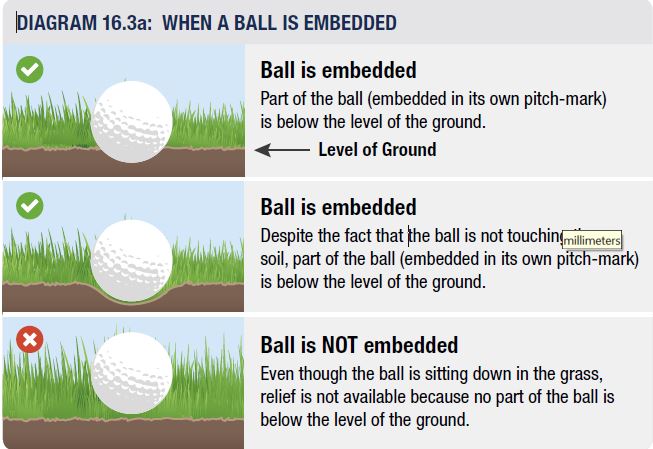In 2019, one of the major rule changes dealt with an embedded ball. Many players still do not understand this rule, but it is important to navigate what a player can and cannot do when their ball is embedded. I came across a great video involving Patrick Cantlay which goes through the steps required to take relief from an embedded ball. This rule is very important in my location because of the wet conditions in the spring and fall. I might be of help to you.
I have written about this rule before and provided a fairly clear description of how rule 16.3 works. My infographic below catches the main points. However, the video below really helps to visually understand what can and cannot be done with an embedded ball.

For those who do not understand what an embedded ball actually looks like, this image from the rule book should help.

And now for the video:
Rule 16.3 – Embedded Ball is a simple, yet underused rule. I personally like all the questions Cantlay asked (although I would suggest he knows the rule very well), especially the ones relating the ball not stopping in a relief spot when dropped. The use of this rule by Cantlay saved him strokes for sure and I think if amateurs understand the embedded ball rule, it would save them strokes as well. Thoughts?
I am a grateful golfer! See you on the links!
Jim, there are a couple of important exceptions to the embedded ball relief rule not mentioned in your post.
Free relief is NOT granted when:
(1) the ball is embedded in SAND in a part of the general area that is not cut to fairway height or less (this does not mean in a bunker), or
(2) interference by anything other than the ball being embedded makes the stroke clearly unreasonable (for example, when a player is unable to make a stroke because of where the ball lies in a bush).
LikeLiked by 1 person
David,
I agree. I am hoping that others that are interested will read the rule for itself. Thanks for adding to the conversation.
Cheers Jim
LikeLiked by 1 person